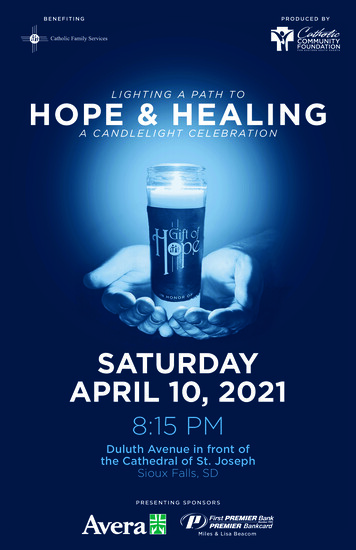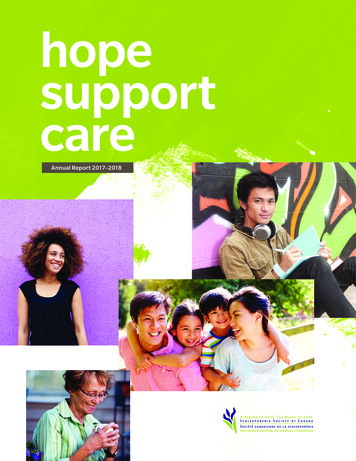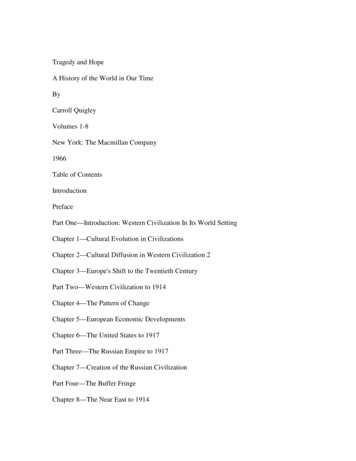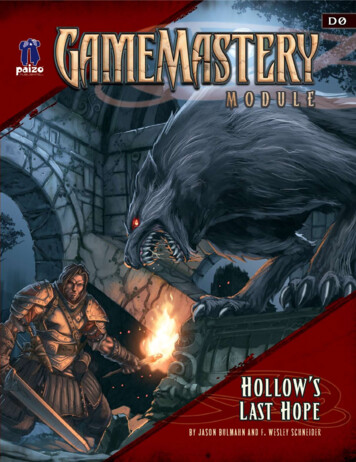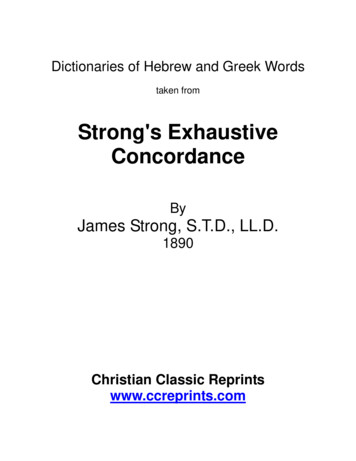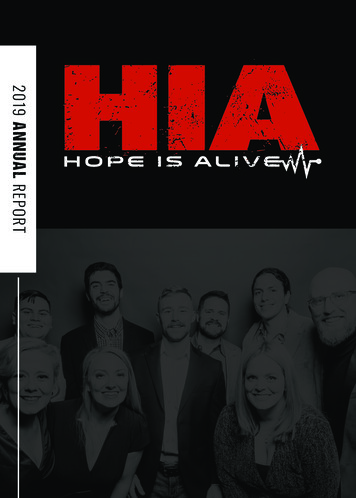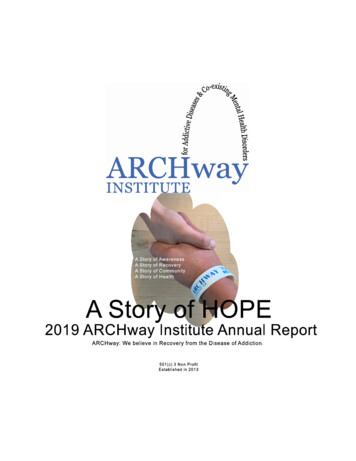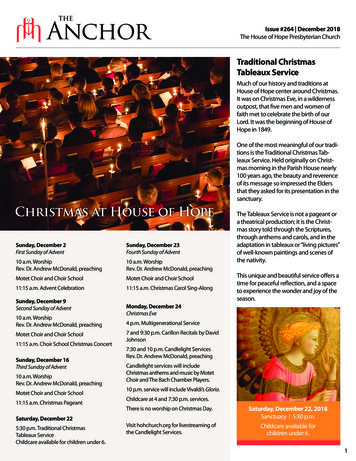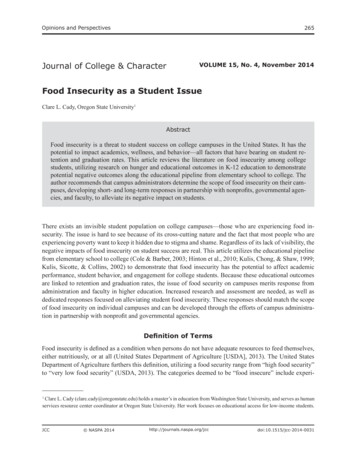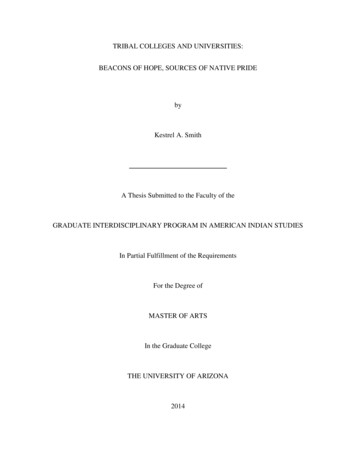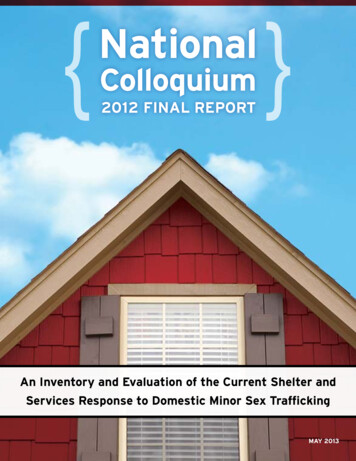
Transcription
NationalColloquium2012 FINAL REPORTAn Inventory and Evaluation of the Current Shelter andServices Response to Domestic Minor Sex TraffickingMAY 2013
NationalColloquium2012 Final ReportAn Inventory and Evaluation of the Current Shelter andServices Response to Domestic Minor Sex Trafficking
Although the term“victim” is usedthroughout thisreport, we recognizethat persons whohave experiencedtrafficking aresurvivors at allstages of their abuseand recovery.
Letter from PartnersThe desperate shortage of shelter and specialized services for victims of sex trafficking, particularly minors,is well known to those of us involved with rescue and restoration. This long-standing problem has recentlybecome more broadly recognized as a result of increased awareness among law enforcement, legislators, childwelfare, and the public in general.In the belief that the timing was right for a national dialogue among those involved with pioneering effortsto minister to this population, and in the hope that documenting such efforts would provide insight forothers we held the National Colloquium: Shelter and Services Evaluation for Action in November 2012.Experts from policy, philanthropy, child welfare, non-governmental organizations and survivor leadershiplinked their own perspectives to emerging trends and barriers encountered in attempting to assist this victim/survivor population. Topics addressed included placement for identified youth, licensing and maintainingresidential facilities and programmatic/therapeutic responses. In addition, a briefing held in coordinationwith the Congressional Caucus for Victims’ Rights and the Congressional Caucus for Women’s Issues dealtwith the issue of funding and sustaining services and shelters.The outline for the event took shape at a preparatory meeting of an Advisory Group and a PractitionerWorking Group in July 2012. Then, in the months leading up to the National Colloquium, we surveyed asmany provider organizations as could be identified in order to gather information about the current stateof shelter and services provision and to determine the most compelling topics for discussion. Forty-oneorganizations responded to the survey. In addition, 33 survivors of sex trafficking replied to a survivordeveloped survey that captured their unique experiences and recommendations.Clearly there is room for multiple models of shelters, programs and therapeutic approaches, and successfuloutcomes cannot be measured by a single set of standards. This report endeavors to capture the voices ofthose that are on the ground today, delivering care despite the many obstacles. We hope their experiences,recommendations and cautions will provide a course, or course correction, to others who would ventureinto this most difficult of endeavors.Linda SmithFounder and PresidentShared Hope InternationalCarol SmolenskiExecutive DirectorECPAT-USADr. Mohamed MattarExecutive DirectorThe Protection ProjectJohns Hopkins UniversitySchool of AdvancedInternational StudiesNATIONAL COLLOQUIUM 2012 FINAL REPORTi
Special ThanksChristy ArnoldBlair BjellosRenee BlairJulia BraunmillerMegan CamachoCarstens Family FundsChildren at Risk (especially Dawn Lew, Esq. and Todd Latiolais)Hannah ClementThe Congressional Caucus for Victims’ RightsThe Congressional Caucus for Women’s IssuesAmy EnglishSean LeeSherif MattarAshley MausTaryn MastreanShamere McKenzieMolly MurphyRepresentative Judge Ted Poe (R-TX)Christine RainoEliza ReockDiva ShresthaHolly SmithLinda SmithElizabeth ScaifeCarol SmolenskiPatrick SweatSamantha Healy VardamanVideofiles, Inc.Nancy WinstoniiMembers of the Restorative Shelter Working GroupNATIONAL COLLOQUIUM 2012 FINAL REPORT
Table of ContentsExecutive Summary. . . . . . . . . . . . . . . . . . . . . . . . . . . . . . . . . . . . . . . . . . . . . . . . . . . . . . . . . .1Recommendations. . . . . . . . . . . . . . . . . . . . . . . . . . . . . . . . . . . . . . . . . . . . . . . . . . . . . . . . . . . 3Introduction. . . . . . . . . . . . . . . . . . . . . . . . . . . . . . . . . . . . . . . . . . . . . . . . . . . . . . . . . . . . . . . . . 7Methodology. . . . . . . . . . . . . . . . . . . . . . . . . . . . . . . . . . . . . . . . . . . . . . . . . . . . . . . . . . . . . . . . 9Chapter 1: Placement and Services for Identified Youth. . . . . . . . . . . . . . . . . . . . . . . . . . . 19Chapter 2: Licensing and Maintaining Programs. . . . . . . . . . . . . . . . . . . . . . . . . . . . . . . . . 37Chapter 3: Funding. . . . . . . . . . . . . . . . . . . . . . . . . . . . . . . . . . . . . . . . . . . . . . . . . . . . . . . . . . 47Chapter 4: Therapeutic/Programmatic Responses . . . . . . . . . . . . . . . . . . . . . . . . . . . . . . . 55Chapter 5: Safety and Security. . . . . . . . . . . . . . . . . . . . . . . . . . . . . . . . . . . . . . . . . . . . . . . . 69Appendix A:National Colloquium: Shelter and Services Evaluation for Action Agenda . . . . . . . . . . . 79Appendix B:Practitioners Working Group and Advisory Committee Members. . . . . . . . . . . . . . . . . . 83Appendix C:National Colloquium Provider Survey. . . . . . . . . . . . . . . . . . . . . . . . . . . . . . . . . . . . . . . . . . 85Appendix D:National Colloquium Survivor Survey. . . . . . . . . . . . . . . . . . . . . . . . . . . . . . . . . . . . . . . . . 183Appendix E:National Colloquium Advocate and Funder Survey. . . . . . . . . . . . . . . . . . . . . . . . . . . . . 205Appendix F:United States Government Agency Request for Report Responses. . . . . . . . . . . . . . . 223Appendix G:State Comparison: Child Protective Services Response. . . . . . . . . . . . . . . . . . . . . . . . . 233NATIONAL COLLOQUIUM 2012 FINAL REPORTiii
Executive SummaryShelter and services for identified victims and survivors of domestic minor sex trafficking (DMST) arecritical for their recovery and success. What has not been immediately available is insight into the actualexperience of the individuals and organizations that are attempting to respond to the need, and theirinsight about possible ways to navigate the obstacles. While a few excellent scholarly articles and manualson how to implement service provision have recently been published, the noticeable missing ingredient isdocumentation of lessons learned, success factors and gaps by those on the ground doing the work. To thatend, the National Colloquium: Shelter and Services Evaluation for Action was conceived and executed byShared Hope International, ECPAT-USA and The Protection Project at Johns Hopkins University Schoolof Advanced International Studies, a triumvirate that has in the past cooperated on related research, notablythe 2006 Mid-Term Review on the Commercial Sexual Exploitation of Children (CSEC) in America inpreparation for the World Congress Against CSEC. Three surveys were designed to capture information thatwill serve as the foundation for the continuing research, site assessments, and discussions among stakeholdersto develop and formalize the shelter and services response for DMST victims. Through these surveys andthe subsequent colloquium, knowledge from a growing body of experts with first-hand experience wasgathered and shared about the actual provision of restorative services to domestic trafficking victims, withall of its successes and setbacks.In July 2012 an Advisory Board and a Practitioners Working Group were convened to review project goalsfor the National Colloquium and vet the survey that would solicit a response from providers across the nationduring the upcoming three months. At the same time, survivor leaders developed and administered theirown survey instrument to capture the unique experiences and perspectives of individuals who have survivedsex trafficking. On November 30, 2012, the National Colloquium: Shelter and Services Evaluation forAction was held, representing a first-ever opportunity for service providers and survivors to hold a structuredconversation about the extraordinarily complex and challenging work of DMST victim and survivor care.Acting Assistant Secretary George Sheldon of the Administration for Children and Families, U.S. Departmentof Health and Human Services, delivered the keynote address that framed the panel discussions that tookplace. Based on their experiences in the field, participants addressed emerging trends and barriers in threeareas: placement for identified youth, licensing and maintaining residential facilities and programmaticand therapeutic approaches. A range of promising practices along with barriers to success were examinedthrough panel discussion and observer interaction.In addition, in coordination with the Congressional Caucus for Victims’ Rights and the CongressionalCaucus for Women’s Issues, a congressional briefing called “Identifying Sustainable Solutions for Shelterand Restorative Care for Victims of Domestic Minor Sex Trafficking” was held to discuss funding for shelterand services for DMST victims, a priority concern noted by advocacy and funding experts that respondedto a third survey designed for this group of stakeholders. The panel for this briefing consisted of humantrafficking experts from government, philanthropy, survivor leadership and non-governmental organizationswho brought visibility to the critical importance of the funding issue.NATIONAL COLLOQUIUM 2012 FINAL REPORT1
Approximately 185 participants filled the U.S. Capitol hearing room and over 500 more attended via a livewebcast in order to be part of this unique event. While information exchange was the stated purpose, acollateral benefit for many was the opportunity for providers and survivors to meet and network with othersdoing similar work in this limited field.SurveysIn preparation for the National Colloquium three national surveys—for providers, for survivors, and foradvocates and funders—were crafted, distributed and completed by over 100 identified expert individualsand organizations.National Colloquium Provider SurveyForty-one organizations providing direct care to DMST victims responded to a 93 question survey on serviceareas, including therapeutic, medical, educational and vocational services provided, licensing and staffingstructure, funding mechanisms, capital and operating costs and safety and security. A full survey summarycan be found in Appendix C of the full report.National Survivor SurveyThirty-three survivors of domestic trafficking responded to a survivor designed and developed survey describingtheir personal experiences with services and recommendations for service provisions. A full survey summarycan be found in Appendix D of the full report.National Advocate and Funder SurveyEighteen advocacy and funding experts in the area of human trafficking, especially DMST, provided insightto trends, research and funding priorities for shelter and services for DMST victims. A full survey summarycan be found in Appendix E of the full report.Reports from U.S. Government AgenciesIn order to gain a complete understanding of the efforts underway by those federal agencies involved withresponding in any way to juvenile sex trafficking in the United States, a short list of questions was craftedto provide these agencies with the opportunity to explain their activities. The complete, unedited responsesare contained in Appendix F of the full report. These responses assisted with the discussion at the NationalColloquium and provide insight into the scope of federal agency activity.2NATIONAL COLLOQUIUM 2012 FINAL REPORT
RecommendationsThe following recommendations are derived from the discussion at the National Colloquium and serve asthe beginning of a framework of core principles in developing shelter and services for victims of domesticminor sex trafficking.1.2.Placement and Services for Identified Youth1.1A uniform method of treatment is not applicable to every identified DMST victim, and thetreatment environment required will change to the extent the survivor embraces the healingprocess. Providers must assess the individualized need of the DMST victims and place them intothe most suitable emergency or long-term services, always with a plan in place to assist them tofull restoration and independence.1.2Coordinated communication between service providers is necessary in order to share informationon available resources and services which will allow involved agencies and providers to providethe services needed at any given point in the restoration process.1.3Information pertaining to the services available to DMST victims must be made easily accessibleto all the involved parties including first line responders, law enforcement, and the service providers.1.4Placements could range from congregate care and foster care to community based care dependingon the specific need and condition of the DMST victim. Treatment and services are not uniformand must be taken on an individualized, case by case basis.1.5More diverse options for placement are needed to prevent barriers to placement resulting fromfunding limitations or any one of a number of characteristics of a DMST victim including:history of running away from another program, altercation within a placement, identificationin the middle of the night or outside programs operating hours, lack of identification of vitalrecords, unavailable parent or guardian, low IQ, pregnancy, addiction or severe mental or physicalhealth needs.1.6First line responders, law enforcement, social workers, therapists, and other stakeholders must betrained to identify and respond to DMST in a trauma-informed and victim-centered manner.Licensing and Maintaining Shelter and Programs2.1Licensing agencies should review and amend or enact regulations as necessary to alleviate barriers or restraints that may dissuade or prevent service and shelter providers from servingparticular youth.NATIONAL COLLOQUIUM 2012 FINAL REPORT3
3.42.2Licenses must be made available for all types of congregate care facilities to meet the diverseneeds of the DMST victim population. This includes emergency, restorative, long term andtransitional housing.2.3Providers need to work closely with licensing authorities to establish realistic licensing andfunding contracts for populations served. License parameters often prohibit or fail to encompassvital components of a DMST treatment program, e.g., survivor mentors may be prohibited fromserving on staff if they have a criminal record; license may not include the ability to attach toother necessary supports such as education or mental health resources.2.4Laws that mandate, establish and financially support residential and community-based programsproviding treatment and case management for DMST victims across the continuum of care areneeded. Service providers are challenged with effective case management when clients are orderedto inappropriate placements, such as ill-equipped foster care, group homes and detention facilities,or they are returned to unsafe home environments.2.5Service providers who consider offering residential services should engage an individual that hasexpertise in the regulatory and compliance aspects of licensing. Residential services providersmust have staff who are knowledgeable about the state and local child welfare and juvenile justicepolicies and practices.Identifying Sustainable Resources3.1Donors and the general public must be educated on the issue of juvenile sex trafficking as distinctfrom other social problems affecting minors and why it deserves attention and funding. Sucheducation must come from many sectors of society including providers, law enforcement,advocates and the concerned public.3.2Potential funders must be led to understand why services for DMST victims tend to be expensivedue to the complex and often lengthy healing process.3.3Shelter and services providers need to establish measurable indicators that are both realistic andquantifiable to demonstrate good stewardships to donors and encourage new investment.3.4Shelter and services providers must diversify funding. Relying solely on government reimbursements or one major funder does not ensure secure sustainable funding.3.5When securing funding to support services for DMST victims, utilizing or braiding funds fromseveral sources can help support the cost of high quality and appropriate care, rather than limitingservice providers to offering just those services covered by a single source.3.6Residential services providers must have staff who are knowledgeable about the state and localchild welfare and juvenile justice policies and practices. If government contracts provide fundingfor the services, this knowledge can leverage and enhance these revenue streams.NATIONAL COLLOQUIUM 2012 FINAL REPORT
4.5.Programmatic/Therapeutic Response4.1Age, socioeconomic status, culture, personality, and other associated factors require that eachvictim have tailored treatment plans. This necessitates flexible and adaptive programming. Eachindividual case is unique and must be treated as unique.4.2Residential facilities need to be staffed with or have regular access to medical and case professionalswho can effectively assist the DMST victims through trauma-informed care. In addition, trainingin trauma-informed care must extend to all staff members, as well as host families or fosterfamilies that may open their homes to DMST survivors.4.3Survivors demonstrating that it is possible to overcome exploitation should be involved in andtake leadership roles in programs and mentorship for sex trafficked youth. This involvement willbe an example to the newly liberated survivors that they too can turn their experience intoassistance for others or powerful advocacy for the cause.4.4Programming must be strengths-based and assist survivors with accessing the inherent skills,abilities and qualities of character they possess but may not recognize. Educational and vocationalopportunities are critical to helping them develop their talents and interests, gain independenceand be active members of their communities.4.5Treatment plans should be designed to lead to self-sufficiency, identifying services that will allow the DMST survivor to transition towards independence. Conversations and formulation ofexit plans are necessary to ensure that DMST survivors understand the value of progressing towards independence.4.6Community and/or family participation is necessary to help in the ultimate success and independence of DMST survivors. Therefore, educational programs, including family counseling,to assist these support systems is imperative.4.7Service providers should offer the opportunity for the DMST survivor to have spiritual needsmet as well as mental, physical and social health needs.Safety and Security5.1Providers must be equipped to identify and respond to internal security risks, such as victims’high flight risk, potential self-harm, harm to others or internal recruitment. All staff and volunteersmust be trained to recognize and de-escalate behavior leading to internal security risks andrecognize that these are often symptoms of trauma that require a therapeutic response.5.2Providers should have a response plan in place for external security threats. Law enforcementshould be aware of the program’s operation and available to respond if an emergency situation arises.NATIONAL COLLOQUIUM 2012 FINAL REPORT5
IntroductionSix years aft
others we held the National Colloquium: Shelter and Services Evaluation for Action in November 2012. Experts from policy, philanthropy, child welfare, non-governmental organizations and survivor leadership linked their own perspectives to emerging trends and barriers encountered
